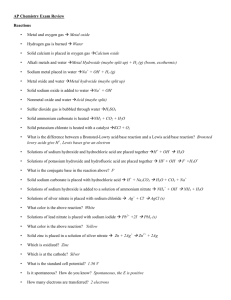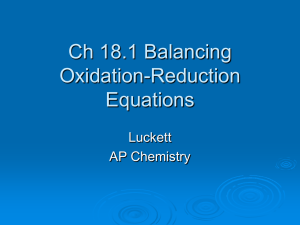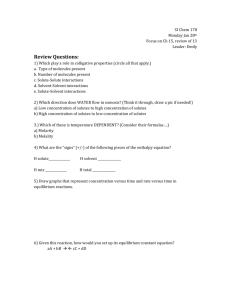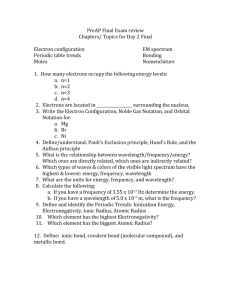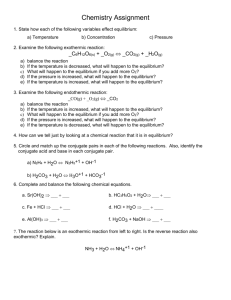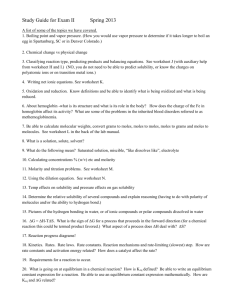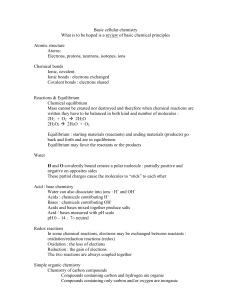Regents Chemistry Review Questions (Equilibrium
advertisement
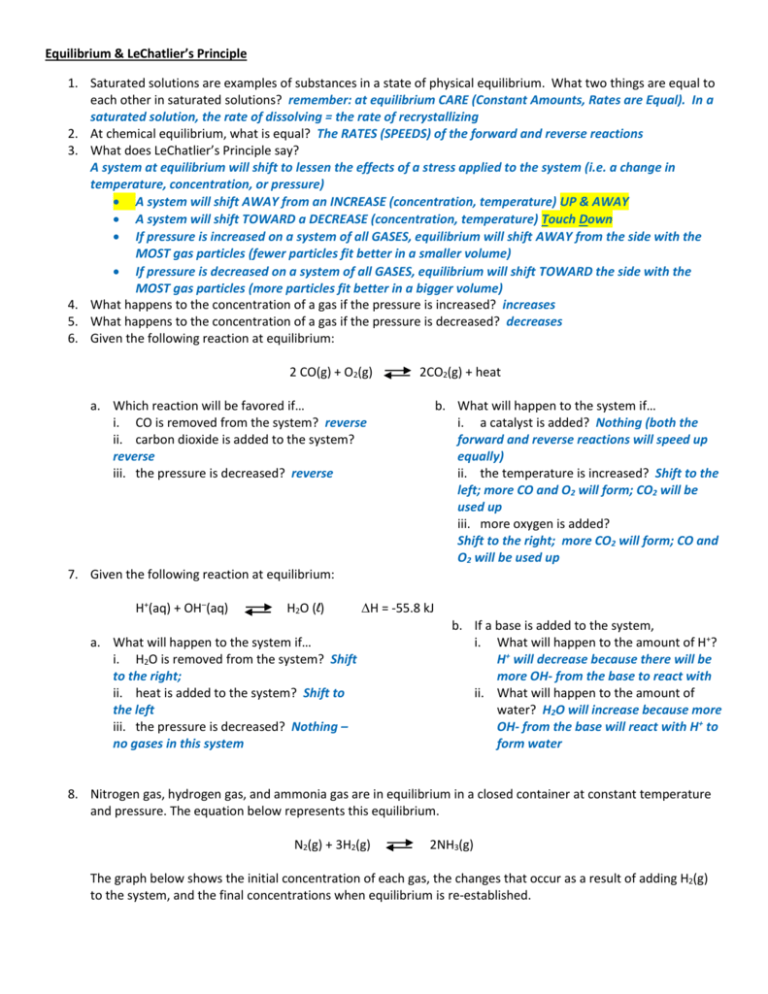
Equilibrium & LeChatlier’s Principle 1. Saturated solutions are examples of substances in a state of physical equilibrium. What two things are equal to each other in saturated solutions? remember: at equilibrium CARE (Constant Amounts, Rates are Equal). In a saturated solution, the rate of dissolving = the rate of recrystallizing 2. At chemical equilibrium, what is equal? The RATES (SPEEDS) of the forward and reverse reactions 3. What does LeChatlier’s Principle say? A system at equilibrium will shift to lessen the effects of a stress applied to the system (i.e. a change in temperature, concentration, or pressure) A system will shift AWAY from an INCREASE (concentration, temperature) UP & AWAY A system will shift TOWARD a DECREASE (concentration, temperature) Touch Down If pressure is increased on a system of all GASES, equilibrium will shift AWAY from the side with the MOST gas particles (fewer particles fit better in a smaller volume) If pressure is decreased on a system of all GASES, equilibrium will shift TOWARD the side with the MOST gas particles (more particles fit better in a bigger volume) 4. What happens to the concentration of a gas if the pressure is increased? increases 5. What happens to the concentration of a gas if the pressure is decreased? decreases 6. Given the following reaction at equilibrium: 2 CO(g) + O2(g) 2CO2(g) + heat a. Which reaction will be favored if… i. CO is removed from the system? reverse ii. carbon dioxide is added to the system? reverse iii. the pressure is decreased? reverse b. What will happen to the system if… i. a catalyst is added? Nothing (both the forward and reverse reactions will speed up equally) ii. the temperature is increased? Shift to the left; more CO and O2 will form; CO2 will be used up iii. more oxygen is added? Shift to the right; more CO2 will form; CO and O2 will be used up 7. Given the following reaction at equilibrium: H+(aq) + OH–(aq) H2O (l) ∆H = -55.8 kJ a. What will happen to the system if… i. H2O is removed from the system? Shift to the right; ii. heat is added to the system? Shift to the left iii. the pressure is decreased? Nothing – no gases in this system b. If a base is added to the system, i. What will happen to the amount of H+? H+ will decrease because there will be more OH- from the base to react with ii. What will happen to the amount of water? H2O will increase because more OH- from the base will react with H+ to form water 8. Nitrogen gas, hydrogen gas, and ammonia gas are in equilibrium in a closed container at constant temperature and pressure. The equation below represents this equilibrium. N2(g) + 3H2(g) 2NH3(g) The graph below shows the initial concentration of each gas, the changes that occur as a result of adding H2(g) to the system, and the final concentrations when equilibrium is re-established. a. What information on the graph indicates that the system was initially at equilibrium? Constant concentrations/amounts b. Explain, in terms of LeChatelier’s principle, why the final concentration of NH3(g) is greater than the initial concentration of NH3(g). More H2 was added to the system. According to LeChatlier’s principle, a system at equilibrium will move away from an increase in concentration. The reaction shifted to the right, which produced more NH3. c. Explain, in terms of collision theory, why the concentration of H2(g) begins to decrease immediately after more H2(g) is added to the system. As more H2 was added, more collisions occurred between reactant particles, which caused them to react and form more NH3. Acids, Bases, and Salts 1. What is something acids, bases, and salts have in common? They are all ELECTROLYTES (conduct electricity in SOLUTION). 2. Which ion do Arrhenius acids release in solution? H+ or H3O+ 3. Which ion do Arrhenius bases release in solution? OH4. What is the alternate definition of an acid? proton donors/H+ donors 5. What is the alternate definition of a base? proton acceptors/H+ acceptors (BAH+!) 6. What is the chemical formula for ammonia? Is it an acid or a base? NH3 (base) 7. Write and balance the chemical equation for the neutralization reaction between carbonic acid and magnesium hydroxide. Name the salt that is produced in this reaction. H2CO3 + Mg(OH)2 2H2O + MgCO3 salt: magnesium carbonate H 4 H 2 4 C 1 C 1 O 5 O 4 5 Mg 1 Mg 1 8. Write and balance the chemical equation for the neutralization reaction between perchloric acid and sodium hydroxide. Name the salt that is produced in this reaction. HClO4 + NaOH H2O + NaClO4 H Cl O Na 2 1 5 1 H Cl O Na salt: sodium perchlorate 2 1 5 1 9. What is molarity? What is the symbol for molarity? moles solute/liter solution; symbol is M 10. What is the molarity of 3 liters of a solution containing 2 moles of NaOH? MB = moles OH-/liter solution MB = 2 moles OH-/3L = 0.67M 11. What is the molarity of 3 liters of a solution containing 2 moles of Ca(OH)2? MB = moles OH-/liter solution MB = 4 moles OH-/3L = 1.3M 12. What is the volume of a 2M solution of HBr that is required to neutralize 10 milliliters of a 5M NaOH solution? MAVA = MBVB 2M x VA = 5M x 10mL VA = 25 mL 13. What is the molarity of a solution of hydroiodic acid if 85mL of 10M calcium hydroxide are needed to neutralize 50mL of the acid? MAVA = MBVB MA x 50mL = 10M x 85mL MA = 17M 14. For the following, state whether a chemical reaction will occur. If so, write and balance the chemical equation. (TABLE J) a. Sn and HCl yes Sn + 2HCl SnCl2 + H2 b. Au and HCl no c. Ca and H2SO4 yes Ca + H2SO4 CaSO4 + H2 d. Pb and HNO3 yes Pb + 2HNO3 Pb(NO3)2 + H2 15. A strong acid spill changes the pH levels of the soil in a field 1000-fold. If the original pH of the soil in the field was 7, what is the new pH of the soil? 1000 = 103 (the pH level changes by 3 units – it is lowered by 3 since it is becoming more acidic) new pH = 4 16. A lake affected by acid rain has a pH of 4.5. A base is added to the lake to neutralize some of the acid. Enough base is added to change the pH of the lake a hundred-fold. What is the new pH of the lake? 100 = 102 (the pH level changes by 2 units – it is raised by 2 since it is becoming more basic) new pH = 6.5 17. Compare the concentrations of H+ and OH- in a neutral solution. they are equal 18. Compare the concentrations of H+ and OH- in an acidic solution. H+ is greater than OH19. Compare the concentrations of H+ and OH- in a basic solution. OH- is greater than H+ 20. What three indicators could be used to differentiate between solutions of pH 3 and 6? Methyl orange, litmus, bromcresol green Redox 1. 2. 3. 4. 5. What is the oxidation state of phosphorus in Na3PO4? +5 What is the oxidation state of sodium in a sample of Na(s)? 0 What is the oxidation state of O in O2? 0 Is an element oxidized or reduced when it loses electrons? (LEO) oxidized Is an element oxidized or reduced when it gains electrons? (GER) reduced 0 0 +1 -1 6. Given the following reaction: H2 + F2 → 2 HF a. Which species is oxidized? H2 b. Which species is reduced? F2 c. In the reaction above, electrons are transferred from H2 to F2 +1 d. Write the balanced half-reaction for the oxidation reaction. H2 2e- + 2H -1 e. Write the balanced half-reaction for the reduction reaction. F2 + 2e- 2F f. If 4 moles of electrons are gained by fluorine, how many moles of electrons must be lost by hydrogen? 4 Electrochemistry 1. What are the three types of compounds (electrolytes) that will conduct electricity in the liquid, molten, or aqueous phases? Acids, bases, and salts 2. What type of element will conduct electricity in the molten phase and as solids? METALS 3. At which electrode does oxidation always occur? (AnOx) ANODE 4. At which electrode does reduction always occur? (RedCat) CATHODE 5. In which direction do electrons flow (from which electrode to which electrode)? From anode to cathode 6. Which electrode always gains mass? Cathode (because positive ions (in solution) are being reduced to form neutral atoms which, being uncharged, do not like to stay in solution and are deposited on the metal strip that forms the cathode) 7. Which electrode always loses mass? Anode (because neutral atoms that make up the metal strip that forms the anode are being oxidized (losing electrons) and forming positive ions that will go into solution – the anode is essentially “dissolving” away) 8. What is another name for a voltaic cell? A battery 9. What is the purpose of the salt bridge in a voltaic cell? To permit the migration (movement) of IONS 10. In a voltaic cell, chemical energy is converted into what type of energy? electrical 11. A voltaic cell involved a (spontaneous, nonspontaneous) redox reaction that (releases, requires) energy. 12. In a voltaic cell, the metal listed higher on Table J is the one that (loses, gains) electrons and is (oxidized, reduced). 13. In an electrochemical cell, the metal listed higher on Table J is the one that (loses, gains) electrons and is (oxidized, reduced). 14. What is electrolysis? Is it spontaneous or nonspontaneous? Does it release or require energy? Electrolysis is a type of redox reaction in which a compound is broken apart into its elements. Ex: 2H2O 2H2 + O2 15. What is electroplating? Is it spontaneous or nonspontaneous? Does it release or require energy? Electroplating is a type of redox reaction in which some material is coated or plated with a metal Ex: gold-plated jewelry Organic Chemistry 1. Refer to notes/blue packet/quiz to review naming of organic compounds. 2. Identify the following type of organic reaction occurring for each of the following: a. nC2H2 → (C2H2)n POLYMERIZATION b. C4H10 + Cl2 → C4H9Cl + HCl SUBSTITUTION c. C6H12O6 → 2C2H5OH + 2CO2 FERMENTATION d. C5H10 + H2 → C5H12 ADDITION e. C2H4 + I2 → C2H4I2 ADDITION f. C2H4 + 3 O2 2 H2O + 2 CO2 COMPLETE COMBUSTION g. CH3COOH + CH3OH CH3COOCH3 + H2O ESTERIFICATION 3. Write the word equation for a saponification reaction. Ester + base soap + alcohol 4. What are the products of complete combustion? CO2 and H2O 5. What are the products of incomplete combustion? CO and H2O 6. What are three natural polymers? Starches, proteins, cellulose 7. What are three synthetic polymers? Nylon, rubber, plastics (polyethylene) Miscellaneous 1. Which measurement contains a total of three significant figures? (0.010g, 0.01g, 0.0100g, 0.01000g) 2. Balance the following chemical reactions and identify the type(s) of reaction they are. a. N2 + O2 → N2O5 2N2 + 5O2 → 2N2O5 Synthesis, redox b. Al + CuSO4 → Al2(SO4)3 + Cu 2Al + 3CuSO4 → Al2(SO4)3 + 3Cu Single replacement, redox c. NaOH + H3PO4 → Na3PO4 + H2O 3NaOH + H3PO4 → Na3PO4 + 3H2O Neutralization, double replacement d. ZnBr2(aq) + AgNO3(aq) → Zn(NO3)2(aq) + AgBr(s) ZnBr2(aq) + 2AgNO3(aq) → Zn(NO3)2(aq) + 2AgBr(s) Double replacement e. Al(s) + CuCl2(aq) → AlCl3(aq) + Cu(s) 2Al(s) + 3CuCl2(aq) → 2AlCl3(aq) + 3Cu(s) Single replacement, redox f. 2Ag2O(s) → 4Ag(s) + O2(g) 2Ag2O(s) → 4Ag(s) + O2(g) Decomposition, redox (electrolysis)

